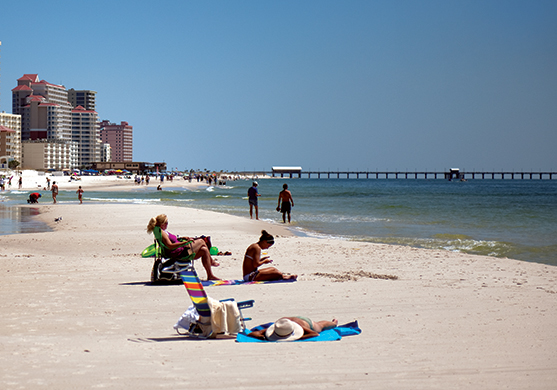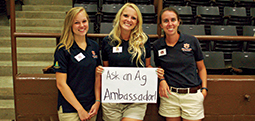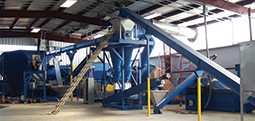| Current Issue | Past Issues | Subscribe | Ag Homepage |

Beyond the Horizon
Against a beautiful backdrop of blue skies and Alabama’s trademark white-sand beaches, the somber network news reporter delivered the grim forecast: By this time tomorrow, he assured his viewers, this pristine beach will be covered by six inches of oil.
That dire prediction out of Orange Beach in early June 2010 never came to pass, but that part of the story didn’t make the news. And in the meantime, a whole lot of damage had been done.
“What you had was round-the-clock reporting, much of which was based on nothing more than speculation,” says Auburn University associate professor Terry Hanson. “That kind of thing had a serious psychological effect.”
It did on him, anyway. As an aquacultural economist, Hanson is aware of the dramatic impact public perception can have on consumer demand, bottom lines and economic survival, and he admits that as days turned into weeks and oil continued to flow unabatedly from the Deepwater Horizon wellhead, he, too, developed a fatalistic outlook.
“As devastating as a hurricane can be, it comes, and, just that quickly, it goes, and you start rebuilding,” Hanson says. “But this was an absolute unknown. Nobody knew when it would end or what kind of impact it was going to have, not only on the environment but on the economy as well.”
“I started thinking, ‘OK, this is the end.’ ”
An economic analysis of the Gulf oil spill’s impact on marine-based industries in Mobile and Baldwin counties that he and research assistant Jeana Baker published in May has eased that fear, at least as far as one major sector of Alabama’s coastal economy—tourism—is concerned.
In the two-year study funded by the Mississippi-Alabama Sea Grant Consortium, Hanson and Baker focused on three sectors of the coastal economy that are dependent on the Gulf of Mexico: commercial fishing, seafood processing and tourism. Specifically, they were examining each sector in terms of job numbers, employee earnings and sales per employee, comparing data from the year before, the year of and the year after the BP spill.
“Tourism has made a remarkable rebound,” Hanson says. “In 2011, overall tourism on the Gulf Coast was the highest ever in terms of jobs, employee earnings and sales generated off of job numbers.”
Led by hotels and full-service restaurants, the tourism industry on the coast added 746 jobs from 2009 to 2011, bringing the total to 27,257 jobs. Total earnings jumped $29.7 million, to $498 million, and sales associated with employee earnings topped $1.54 billion, an increase of $83 million from the year before the oil spill.
Hotels had the highest sales gain, at $32.8 million, followed by full-service restaurants, which boosted sales by $26.6 million and limited-service eateries, where sales increased by $13.7 million over the three-year period. The biggest losses of sales were in residential property management, down $7 million; drinking establishments, down $2 million; and marinas, posting a drop of $1.2 million.
But tourism’s economic rebound from the BP gusher has not carried over to the two remaining marine-based sectors—commercial fishing and seafood processing—which Hanson says were on the downhill slide, in terms of job numbers, in both Mobile and Baldwin counties throughout the first decade of the 21st century.
“They were still trying to recover from natural and man-made disasters—hurricanes Katrina and Rita, a significant increase in seafood imports, higher fuel prices and the ‘Great Recession,’” Hanson says. “The oil spill event hastened the long-term trend of declining sales in seafood processing and wholesaling and in commercial fishing.”
According to the Hanson-Baker study:
• The number of jobs in fresh and frozen seafood processing/wholesaling fell from 959 in 2009 to 770 last year, representing a $3.5 million drop in earnings and a $21.2 million decline in sales associated with lost jobs.
• The commercial finfish and shellfish fishing industry lost 13 total jobs and $700,000 in earnings from 2009 through 2011, and sales generated per employee dropped $1.1 million.
The processing numbers come as no surprise to Chris Nelson, whose family has owned and operated Bon Secour Fisheries for 100-plus years. He says Alabama’s seafood industry is up against a multitude of monumental spill-related hurdles, from overcoming unnecessary but lingering consumer and wholesale buyer concerns about the safety of Gulf seafood to regaining market share that was lost to imports when Alabama’s off-shore waters were closed to commercial fishing in the spill’s aftermath.
Throughout its decades in existence, Bon Secour Fisheries has weathered probably too many hurricanes and other natural disasters to count. But Nelson says those pale in comparison to the 2010 oil spill. This, he says, has been and continues to be “far more detrimental and long-lasting than hurricanes.”
Meanwhile, Hanson has teamed with Auburn agricultural economics professor Diane Hite, rural sociology assistant professor Michelle Worosz and geography professor Luke Marzen in a broad Sea Grant–sponsored research project to analyze the socioeconomic impacts that threats and disturbances—whether meteorological, technological or economic in nature—have on waterfront-related businesses, tourism and the seafood supply chain, not only in Alabama’s Baldwin and Mobile counties but in Mississippi’s coastal counties of Jackson, Harrison and Hancock as well.
The researchers’ goal in the two-year investigation is to find ways to ensure that the social, cultural and economic fabric of the coastal communities remains strong and resilient.
“The major challenge for coastal Alabama communities lies in economic diversification,” Hanson says. “Ultimately, community resiliency strengthens, stabilizes and protects economies from epic shocks, be they natural or human-made.”
The new project’s seafood supply chain research component, led by Worosz, began in June and involves confidential face-to-face interviews with as many people as possible at all levels of the shellfish supply chain, from commercial shrimpers to seafood restaurant chefs, to learn how the oil spill and other disasters affected these businesses, how they are faring post–oil spill and how they view the effectiveness of food safety testing procedures and regulations in helping improve consumer confidence in Gulf Coast seafood.
“This data is critical to putting a face to the economic data,” Worosz says. “It will provide a detailed case study that represents the lived experiences of individuals who are central to working waterfronts.”
To participate in the survey, contact graduate research associate Stefanie Christensen at skc0014@auburn.edu.
September 2012
Ag Illustrated

Cultivating the Cream of the Crop
College of Ag’s Best Assets—Its People by







